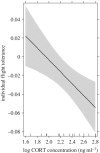Stress hormones predict a host superspreader phenotype in the West Nile virus system
- PMID: 28724737
- PMCID: PMC5543230
- DOI: 10.1098/rspb.2017.1090
Stress hormones predict a host superspreader phenotype in the West Nile virus system
Abstract
Glucocorticoid stress hormones, such as corticosterone (CORT), have profound effects on the behaviour and physiology of organisms, and thus have the potential to alter host competence and the contributions of individuals to population- and community-level pathogen dynamics. For example, CORT could alter the rate of contacts among hosts, pathogens and vectors through its widespread effects on host metabolism and activity levels. CORT could also affect the intensity and duration of pathogen shedding and risk of host mortality during infection. We experimentally manipulated songbird CORT, asking how CORT affected behavioural and physiological responses to a standardized West Nile virus (WNV) challenge. Although all birds became infected after exposure to the virus, only birds with elevated CORT had viral loads at or above the infectious threshold. Moreover, though the rate of mortality was faster in birds with elevated CORT compared with controls, most hosts with elevated CORT survived past the day of peak infectiousness. CORT concentrations just prior to inoculation with WNV and anti-inflammatory cytokine concentrations following viral exposure were predictive of individual duration of infectiousness and the ability to maintain physical performance during infection (i.e. tolerance), revealing putative biomarkers of competence. Collectively, our results suggest that glucocorticoid stress hormones could directly and indirectly mediate the spread of pathogens.
Keywords: competence; glucocorticoid; resistance; tolerance; transmission.
© 2017 The Author(s).
Conflict of interest statement
We declare we have no competing interests.
Figures

 , p = 0.029). The grey shaded bar between 4 and 6 days-post-inoculation on the x-axis indicates the period of peak infection intensity detected via quantitative-PCR in CORT+ and CORT++ hosts. The black, large-dashed line at the top (no mortality) corresponds to the control treatment; the blue, large-dashed line (middle) corresponds to the CORT+ treatment, and the red dotted line corresponds to the CORT++ treatment. (Online version in colour.)
, p = 0.029). The grey shaded bar between 4 and 6 days-post-inoculation on the x-axis indicates the period of peak infection intensity detected via quantitative-PCR in CORT+ and CORT++ hosts. The black, large-dashed line at the top (no mortality) corresponds to the control treatment; the blue, large-dashed line (middle) corresponds to the CORT+ treatment, and the red dotted line corresponds to the CORT++ treatment. (Online version in colour.)
 , p < 0.0001), time (
, p < 0.0001), time ( , p < 0.0001) and the interaction between treatment and time (
, p < 0.0001) and the interaction between treatment and time ( , p < 0.0001) predicted host viremia. At peak viremia levels, hosts in the CORT+ and CORT++ treatments (square and triangle symbols, respectively) had viral infection intensities that were approximately 2 orders of magnitude greater than those of control birds (circle symbols). The horizontal dashed line at 105 pfu WNV ml−1 indicates the proposed threshold for transmission of WNV from bird to mosquito; only birds in the elevated CORT treatments attained viremia levels above this transmission threshold. Points represent averages at sampled time points over the study. Error bars are ±1 s.e. of the mean. (Online version in colour.)
, p < 0.0001) predicted host viremia. At peak viremia levels, hosts in the CORT+ and CORT++ treatments (square and triangle symbols, respectively) had viral infection intensities that were approximately 2 orders of magnitude greater than those of control birds (circle symbols). The horizontal dashed line at 105 pfu WNV ml−1 indicates the proposed threshold for transmission of WNV from bird to mosquito; only birds in the elevated CORT treatments attained viremia levels above this transmission threshold. Points represent averages at sampled time points over the study. Error bars are ±1 s.e. of the mean. (Online version in colour.)

Similar articles
-
Distinct effects of acute versus chronic corticosterone exposure on Zebra finch responses to West Nile virus.Conserv Physiol. 2019 Dec 5;7(1):coz094. doi: 10.1093/conphys/coz094. eCollection 2019. Conserv Physiol. 2019. PMID: 31824675 Free PMC article.
-
The effect of exogenous corticosterone on West Nile virus infection in Northern Cardinals (Cardinalis cardinalis).Vet Res. 2012 Apr 21;43(1):34. doi: 10.1186/1297-9716-43-34. Vet Res. 2012. PMID: 22520572 Free PMC article.
-
West Nile virus emergence and large-scale declines of North American bird populations.Nature. 2007 Jun 7;447(7145):710-3. doi: 10.1038/nature05829. Epub 2007 May 16. Nature. 2007. PMID: 17507930
-
[West Nile virus. Prevalence and significance as a zoonotic pathogen].Bundesgesundheitsblatt Gesundheitsforschung Gesundheitsschutz. 2004 Jul;47(7):653-60. doi: 10.1007/s00103-004-0864-x. Bundesgesundheitsblatt Gesundheitsforschung Gesundheitsschutz. 2004. PMID: 15254820 Review. German.
-
On the Fly: Interactions Between Birds, Mosquitoes, and Environment That Have Molded West Nile Virus Genomic Structure Over Two Decades.J Med Entomol. 2019 Oct 28;56(6):1467-1474. doi: 10.1093/jme/tjz112. J Med Entomol. 2019. PMID: 31549720 Free PMC article. Review.
Cited by
-
Viral Diversity of Microbats within the South West Botanical Province of Western Australia.Viruses. 2019 Dec 13;11(12):1157. doi: 10.3390/v11121157. Viruses. 2019. PMID: 31847282 Free PMC article.
-
Extreme Competence: Keystone Hosts of Infections.Trends Ecol Evol. 2019 Apr;34(4):303-314. doi: 10.1016/j.tree.2018.12.009. Epub 2019 Jan 29. Trends Ecol Evol. 2019. PMID: 30704782 Free PMC article. Review.
-
The impact of stress and anesthesia on animal models of infectious disease.Front Vet Sci. 2023 Feb 2;10:1086003. doi: 10.3389/fvets.2023.1086003. eCollection 2023. Front Vet Sci. 2023. PMID: 36816193 Free PMC article. Review.
-
Cellular and immunological mechanisms influence host-adapted phenotypes in a vector-borne microparasite.Proc Biol Sci. 2022 Feb 23;289(1969):20212087. doi: 10.1098/rspb.2021.2087. Epub 2022 Feb 23. Proc Biol Sci. 2022. PMID: 35193398 Free PMC article.
-
Distinct effects of acute versus chronic corticosterone exposure on Zebra finch responses to West Nile virus.Conserv Physiol. 2019 Dec 5;7(1):coz094. doi: 10.1093/conphys/coz094. eCollection 2019. Conserv Physiol. 2019. PMID: 31824675 Free PMC article.
References
-
- Laugero KD, Moberg CP. 2000. Energetic response to repeated restraint stress in rapidly growing mice. Am. J. Physiol. Endocrinol. Metab. 279, E33–E43. - PubMed
MeSH terms
Substances
LinkOut - more resources
Full Text Sources
Other Literature Sources
Medical
Miscellaneous

